 |

| |
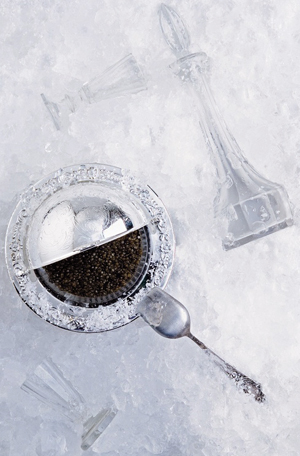
It’s not an unaffordable luxury—now, with sustainable (farmed or humanely-fished) caviars, it’s the luxury you deserve. Photo by Sergey Gavrilov | Fotolia. |
| WHAT IT IS: The great caviars of the world: sustainable black, red and other caviars. |
| WHY IT’S DIFFERENT: No pretentiousness here: They just want you to learn about, and appreciate, the best caviars. For $65 a month (Caviar Club), you can get ongoing shipments of different varieties and experience the heavenly world of fine caviar. |
| WHY WE LOVE IT: It’s very, very fresh—no middleman is holding the goods. You deal with experts who are passionate about caviar. It's all they do. And, it couldn’t be easier—just phone by 5 p.m. Central Time and you’ll have your order the next day. |
| WHERE TO BUY IT: TheLittlePearl.com |
|
|
 |

The Little Pearl:
Join The (Caviar) Club
If you already love caviar, or would like a chance to study it, The Little Pearl wants to help. A purveyor of sustainable caviars from all over the world, including those farmed in the U.S., there is no intimidation, mystery or pretentiousness here: It’s a friendly place to learn about caviar (so is THE NIBBLE’s Caviar Section).
The caviar is very fresh, with a firm texture and mild taste—no saltiness or fishiness. You can taste the species character and terroir in each bite. Each jar is packed to order.
The black caviars include American Sturgeon, Bowfin, farmed Osetra from Germany, Spoonbill Paddlefish, Transmontanus Rex (our favorite!) from the U.S. and Uruguayan Baerii (runner up). There are three types of salmon caviar—Keta, King and Yukon Gold—plus Golden Whitefish and Rainbow Trout. (Read more about them in our Caviar Glossary.)
While The Little Pearl has some products for high rollers (for $1,200 and up plus travel expenses, a caviar sommelier will come to you and conduct a tasting for eight to ten), the rest of us can enjoy a tasting sampler for $150 or can join the Caviar Club and get a different shipment each month ($65/month). It’s a perfect treat or luxury gift; low calorie and high protein; sustainable; and very special. Now, you don’t have to envy how the other half lives—you can be the other half. Read the full review below.
- Read reviews of more of our favorite caviars and roes in THE NIBBLE online magazine.
- See the Table of Contents of the November issue of THE NIBBLE, plus the back issues archive and our most popular articles.
- All of the Top Pick Of The Week newsletters are permanently archived on TheNibble.com, in chronological order and by product category.
|
| |
|
|
THE NIBBLE does not sell the foods we review
or receive fees from manufacturers for recommending them.
Our recommendations are based purely on our opinion, after tasting thousands of products each year, that they represent the best in their respective categories. |
Learn More About Caviar
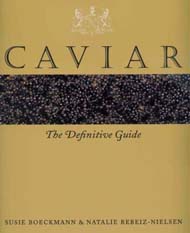 |
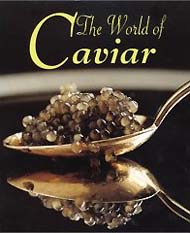 |
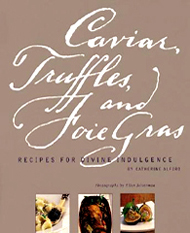 |
| Caviar: The Definitive Guide, by Susie Boeckmann. From the history of caviar to serving, matching beverages and recipes. Click here for more information or to purchase. |
The World of Caviar, by Olivier Le Goff. An A to Z guide for all things caviar. Click here for more information or to purchase. |
Caviar, Truffles, and Foie Gras: Recipes for Divine Indulgence, by
Katherine Alford. A well-researched introduction to each of these luxury foods, along with recipes for every course. Click here for more information or to purchase. |
The Little Pearl: Caviar Club
INDEX OF REVIEW
|
MORE TO DISCOVER
|
Sturgeon, the fish that produce the choicest caviar, have roamed the seas and rivers of the world for 250 million years—predating the dinosaurs, who first appeared around 230 million years ago.* They were enjoyed by prehistoric man and have been fished commercially for their meat and eggs since 1100 B.C.E. by the Azeris and Persians, who settled at rivers leading to the Caspian Sea, spawning grounds for the great fish.
*The dinosaurs died out around 65 million years ago; fortunately, they did not take the sturgeon with them.
Rare today, caviar was a delicacy even in Greco-Roman times. The first written record of caviar is by none other than Aristotle in the fourth century B.C.E. He described how the sturgeon eggs were carried into banquets heralded by trumpets and floral tributes. King Edward II of England (who reigned from 1302 to 1327) claimed all sturgeon as property of the king. He was ultimately deposed and murdered, although not by caviar activists.
The Russian czars and aristocrats famously enjoyed caviar; their caviar of choice was not beluga but the golden roe of the sterlet sturgeon, which became known as “Imperial” caviar and was the most coveted type. Alas, the sterlet has been overfished to the point of near-extinction, and the three largest Caspian sturgeon, the beluga, osetra and sevruga, are on the Endangered Species List of the World Conservation Union.
The Golden Imperial Caviar shown at right, from the osetra sturgeon, is available from GourmetFoodStore.com.
|
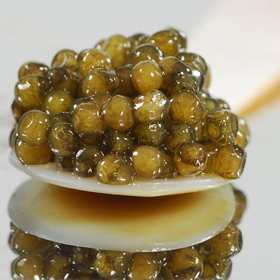
Golden caviar—not from the Czars’ favorite sterlet sturgeon, which has been fished to near-extinction, but from the osetra sturgeon. |
Caviar has been so cheap at times that it was kept as food by the poor fisherman who sold off the meat, and it was given away free like peanuts and pretzels at American bars in the early 1900s. Today it is the most expensive food on earth. You can pay $350 an ounce for prime Iranian osetra, which makes white Alba truffles seem left far behind in the luxury race—until you realize that an ounce of lightweight truffle goes much farther than an ounce of heavy caviar (it will season a dish for the entire table, whereas one ounce of caviar leaves one person wanting another six ounces).
What Is Caviar And What Is Roe?
The answer is different depending upon where you live, and whether or not you’re a biologist or a caviar processor.
- The French government legally defines caviar as the eggs of sturgeon. All else is roe.
- Formerly in the U.S., caviar referred only to the eggs of sturgeon. Today, any fish eggs can be called caviar, as long as the name of the fish precedes the word: salmon caviar, whitefish caviar, etc.
- The U.S. Food and Drug Administration defines roe as unsalted fish eggs; caviar is salted fish eggs. That is how the products are referred to in the caviar trade. However, the terms are used interchangeably in retail and culinary circles—salmon roe, salmon caviar; trout roe, trout caviar; etc.
- In much of northern Europe, black caviar means dyed lumpfish or whitefish caviar.
- In Sweden, kaviar is a pink sandwich paste made from cod roe (see photo at right).
- To biologists, caviar is the unfertilized eggs of fish, whereas roe defines eggs that have been fertilized and already laid.
|

Real caviar doesn’t come in tubes! This codfish paste called kaviar was launched in 1954 in Sweden. You can get it at GenuineScandinavia.com. Kalle’s is the brand name (Kalle is the boy on the tube—his father was the managing director of the company at the time of the launch). |
Whether you call it caviar or roe, the eggs are lightly salted to preserve them. More about that shortly.
Is “Caviar” Russian for “Sturgeon Eggs?”
Nyet. One might expect the word “caviar” to be Russian in origin, but it isn’t. It derives from the Persian (Farsi), khag-avar, which means “roe-generator.” The Turkish word hayvar, for egg, became caviar during trade with Italy and France in the 16th century (the word first appears in print in English in 1591). And the Russians refer to caviar as ikroj, roe, modifying the word with the particular type of roe (beluga, sturgeon, salmon, trout, etc.).
Most people associate caviar with the Caspian Sea, the world’s largest lake. It is a vast body of water bordered by five countries: the Russian Federation to the northwest, Kazakhstan to the north and 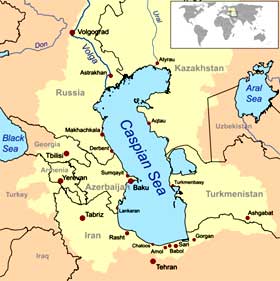 northeast, Azerbaijan on the southern part of the western shore, Turkmenistan on the southern half of the eastern shore and Iran on the southern shore. The Caspian is home to seven different sturgeon species. The major caviar species fished for caviar, the enormous beluga (up to 30 feet long and 3,300 pounds), the osetra (up to 10 feet and 500 pounds) and the sevruga (6.5 feet and 175 pounds), are all on the Endangered Species List. Last year, the Convention on International Trade in Endangered Species of Wild Fauna and Flora (CITES) developed a list of conservation measures that included the restriction of Caspian caviar sales to those nations that bordered the Caspian. This measure was meant to curtail the illegal poaching that is partially responsible for the decline of the sturgeon (pollution and damming of rivers, which are the sturgeons’ spawning grounds, the killing of the sturgeon to take their eggs, and extensive illegal poaching are the others). Over the past 10 years, other countries have begun caviar farming, for both preservation and to meet consumer demand. The beluga is too large to be farmed, but the osetra has found success, as you’ll see in the tasting notes below. Map of Caspian Sea courtesy of Wikipedia.org. northeast, Azerbaijan on the southern part of the western shore, Turkmenistan on the southern half of the eastern shore and Iran on the southern shore. The Caspian is home to seven different sturgeon species. The major caviar species fished for caviar, the enormous beluga (up to 30 feet long and 3,300 pounds), the osetra (up to 10 feet and 500 pounds) and the sevruga (6.5 feet and 175 pounds), are all on the Endangered Species List. Last year, the Convention on International Trade in Endangered Species of Wild Fauna and Flora (CITES) developed a list of conservation measures that included the restriction of Caspian caviar sales to those nations that bordered the Caspian. This measure was meant to curtail the illegal poaching that is partially responsible for the decline of the sturgeon (pollution and damming of rivers, which are the sturgeons’ spawning grounds, the killing of the sturgeon to take their eggs, and extensive illegal poaching are the others). Over the past 10 years, other countries have begun caviar farming, for both preservation and to meet consumer demand. The beluga is too large to be farmed, but the osetra has found success, as you’ll see in the tasting notes below. Map of Caspian Sea courtesy of Wikipedia.org.
United States: Former Caviar King Of The World
It may surprise many caviar fans to learn that in the 19th century, the U.S. was the world’s leading producer. The American caviar industry began in 1873 when Henry Schacht, a German immigrant, opened a sturgeon-fishing business on the Delaware River in Penns Grove, New Jersey, where sturgeon were plentiful. Schacht created the first company to distribute caviar throughout the world, selling it throughout the U.S. and exporting it to Europe for $1.00 a pound. Other entrepreneurs soon followed, and by the end of the century, the U.S. was the largest exporter of caviar. Ironically, much of the exported caviar was re-imported to the U.S. labeled “Russian caviar,” a more prestigious product.
By the end of the 19th century, America was producing 90% of the world’s caviar. Our rivers were rich with sturgeon: 3,500 tons of caviar were harvested from the Delaware and Hudson Rivers alone, and, once that supply was depleted, similar amounts came from the Pacific Northwest, particularly the Columbia River in Oregon. Caviar was so plentiful that caviar was routinely served during free lunches in saloons (lunch and caviar were complimentary with the purchase of a nickel beer). As with pretzels and peanuts, the salt engendered thirst and beer sales.
But finally, the American sturgeon was over-fished nearly to the point of extinction. Suddenly, sturgeon caviar was an exorbitant luxury. After World War II, when America again turned its focus to caviar, affordable caviars were sought. In the 1960s the Romanoff Caviar Company, originally established in 1859 in the caviar boom days, began to promote affordable red salmon caviar, dyed lumpfish caviar, and later in 1982, golden whitefish caviar. Today, whitefish caviar is infused with wonderful flavors and natural colors to create an artist’s palette of delights, and sturgeon farming is going full-throttle in the U.S., Europe, Israel, South America and other points around the globe. |
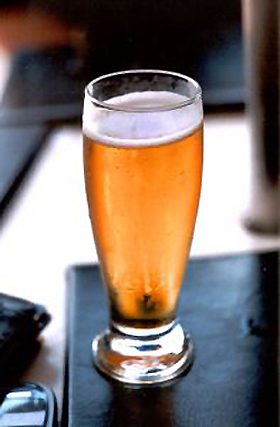
Free caviar with beer: In the early 20th century, sturgeon caviar was so plentiful in the U.S., they
were giving it away like bar peanuts, to make
people thirsty for beer. Photo by Leonardo Sanches | SXC. |
About Caviar
What makes top-quality caviar—the type you bite into and say, “Worth every cent!?”
- The fish live in pristine water
- They have the best feed—what the fish eat prior to harvesting directly impacts the flavor (the best farmed sturgeon are fed wild shrimp)
Preparation is also critical. The methodology—which was invented by the Chinese for the preservation of carp roe—has remained the same for thousands of years. It is very labor intensive, and one of the reasons that caviar prices are so high (although the markups of the middlemen are the principal reason—the fish do not sell for a huge amount, and an entire poached sturgeon [illegally caught by poachers] can be bought for as little as $5.00).
First, the roe is removed from the sturgeon. The most common method of extracting the eggs involves the actual killing of the fish, either before or after the removal of the egg sack—one reason why wild sturgeon, which take so many years to mature, are an endangered species. Farmed and sustainably fished sturgeon are not killed. The eggs are removed in a more laborious process (think of it as a sturgeon c-section) and the fish is returned to the water.
The roe is sieved through screens to remove fatty tissue and membrane, and then filtered into different sizes, after which it is carefully cleaned and rinsed. Next, it is classified by size and color: 000 eggs are the largest and palest, and 0 are the smallest and blackest. The most desirable—and the most expensive—are 000 grade.
|
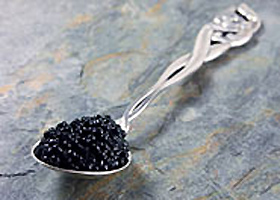
These eggs, small and black, would be graded more toward 0 than 000. |
Now, the roe is ready to be salted, when it will officially become caviar. The salt is used to preserve the freshness of the caviar. A special kind of non-iodized salt is used, from the city of Astrakhan, just north of the Caspian on the Volga River (which itself is rich in sturgeon). The salt has low chlorine content to begin with, but is stored for seven years to enable any chlorine to evaporate. Because of the superiority of the salt, Iranian caviar producers now use it as well, so that today the Russian and Iranian caviars are almost indistinct in flavor and texture.
The finer the caviar, the less salt is used to impact the flavor (and also, the more perishable the product). Malossol caviar—the word means “little salt”—indicates that the caviar is of the finest quality and the least amount has been used. When you see a tin marked “Malossol 000,” it’s the best Caspian caviar that money can buy. (However, caviar is not sold this way in the U.S. Like mattresses, it tends to be sold with marketing names, so that the consumer can’t compare grade to grade, apple to apple). Traditionally, borax (sodium borate, the same product added to detergents) has been added to provide extra sweetness. Borax is not a legal food additive in the U.S.; so if the caviar tastes sweeter in Europe, consider this factor.
There’s one more factor a sensitive consumer should consider: if the caviar is sustainable. Caspian caviar isn’t. The sturgeon are being driven to extinction. There are options, and based on our tasting, excellent caviar experiences to be had from sustainable fisheries and environmentally sensitive farms. The Little Pearl only sells sustainable caviar—that which is farmed or fished in a responsible 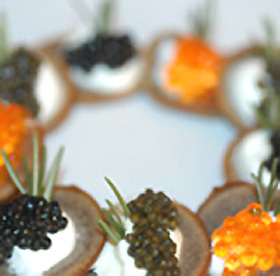 manner that does not deplete the resource. No sturgeon are killed, as with traditional caviar harvesting. The company is a member of Seafood Choices Alliance, Slow Food and the Edible Communities. manner that does not deplete the resource. No sturgeon are killed, as with traditional caviar harvesting. The company is a member of Seafood Choices Alliance, Slow Food and the Edible Communities.
Caring For Caviar
Caviar should be stored at 28 degrees to 32 degrees Fahrenheit. Unopened jars can be stored for four weeks; pasteurized caviar will keep in the refrigerator unopened for several months. Once opened, all caviars should be consumed within two to three days (The Little Pearl does not sell pasteurized caviar, since pasteurization impacts the texture).
The Little Pearl Red Caviars
We began our caviar adventure with a lovely basket of six caviars, that came with its own mother of pearl spoon, tied with a satin ribbon. Some of the caviars we sampled are wild, some are farmed, all are sustainable. One person can polish off the six ounces of caviar as a deluxe treat or a luxurious first course; but two people who are very close can share them. Our experience left us wanting more, but we knew we’d had a privileged experience.
When tasting a variety of caviars, begin with the reds (or other lighter caviars) and then move to the blacks. As with wine or any food, the less complex should be tasted first, building up to the most complex. We tasted the caviars in the order that follows.
Rainbow Trout Caviar:
Buttery & Rich
Much of the trout caviar supply comes from Michigan, but this special rainbow trout caviar is cultured under picturesque Cold Mountain, North Carolina (the same location of novel and film fame), fed with rainwater from Great Smoky Mountain National Park. Many experts call these the world’s finest trout, not surprisingly yielding the finest trout caviar. It’s the tastiest, best-textured, most sophisticated trout caviar we’ve had.
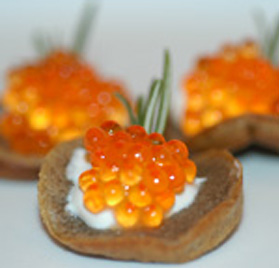
Rainbow Trout Caviar from Cold Mountain, North Carolina. |
A special organic feed produces a bright orange bead† with a firm pop and a surprising density in the mouth. The feed enriches the caviar with omega-3s, producing a complex taste and butteriness. An added nuance of minerals comes from the mountain waters that feed the trout pools. The eggs have a nice amount of salinity without being salty. This is the only salmonid caviar (trout are a member of the salmon family) that ages like sturgeon caviar, acquiring a rich buttery flavor at 30 days.
†The eggs are also known as beads or pearls. |
Yukon Gold Salmon Caviar:
The Unsalty Caviar
If your main acquaintance with salmon caviar is the inexpensive, salty ikura at sushi bars, you’ll be very surprised by how elegant top-grade salmon caviar is. Yukon Gold salmon caviar is harvested from Keta salmon caught in the wide, swift Yukon River and the Tanana River, part of the Yukon’s watershed. The 2,300-mile-long river flows through Alaska’s majestic interior, past Denali (previously known as Mt. McKinley, North America’s largest mountain), and empties into the Bering Sea.
The fish swim 1,800 miles upriver to spawn, stockpiling omega-3 fatty acids. The orange eggs are large for caviar yet small for salmon; they have a wonderful texture that bursts with rich, buttery, intense flavor. There are many species of salmon; the roe of each varies. These taste of their terroir—the Yukon valley’s rich minerals and the brine from Bering Sea krill. There is no salinity: If you want your caviar without saltiness, this is a good choice. But it’s a good choice for any purpose. One can buy generic salmon caviar in any supermarket these days, much of it salty and gummy. As with beef, to give just one example, there are huge differences in quality. The salmon caviars from The Little Pearl are truly exciting.
|
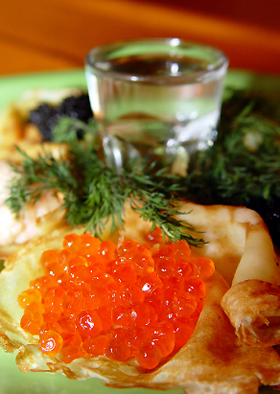
Yukon Gold salmon caviar is harvested from fish that have swum the Yukon River. Photo by Leonid Nishko | IST.
Back to Index |
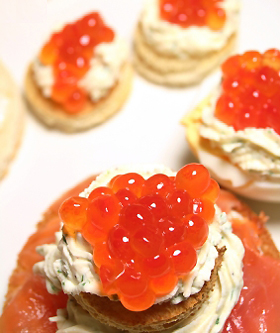
#1 Keta Salmon is harvested from salmon caught in glacial bays and fjords off Juneau, Alaska. Photo by Dirk R | IST.
|
#1 Keta Salmon Caviar:
Mild, Delicate Flavor
The Keta salmon has a lower oil content that helps to give it a mild, delicate flavor. It is the meatiest of the salmon species, with the firmest texture of the wild salmon. #1 Keta caviar is harvested from Keta caught in the glacial saltwater bays and fjords off Juneau, Alaska. This traditional red caviar has the largest sized egg, but a relatively mild flavor for salmon caviar. The eggs have a distinct, briny salmon flavor from their diet of krill. Excellent processing preserves freshness and means that only a minimum amount of salt is needed. This elegant salmon caviar has nothing to do with the salmon caviar we typically have access to. Of course, it costs much more than we’ve typically paid; but now, thanks to The Little Pearl, our eyes are opened. The salmon egg deserves as much respect and attention as the sturgeon egg.
|
The name “#1 Keta” was chosen by The Little Pearl to designate the top quality salmon caviar. Is it better than Yukon Gold? It’s more delicate, so it depends on what your palate prefers. The enjoyable journey at The Little Pearl consists of trying all of the choices. There’s a King salmon caviar, also from the Yukon River, that we haven’t had yet. Our next order will be a flight focusing on all four reds: the rainbow trout and the three salmons.
The Little Pearl Black Caviars
We tasted all of the caviars plain, to focus and extract every nuance of flavor from every bead. But what if you want to imbibe with the caviars? Russians traditionally pair their caviar with vodka. While that might work with lesser caviars, especially with the salty, oily pressed caviar, we find the alcohol and pepperiness of vodka too overwhelming for the good stuff. Champagne, Grüner Veltliner, Pinot Blanc and dry Riesling are much better companions.
Spoonbill Paddlefish Caviar:
Cousin Of The Sturgeon
Elsewhere called paddlefish caviar, but known by either name, the spoonbill paddlefish (Polyodon spathula) is an ancient filter feeder, a cousin of the sturgeon. It is wild caught in the rivers of Tennessee and Ohio, and also found in Indiana, Mississippi, Missouri and Montana, where it can be seen swimming upside down, feeding on small shrimp near the surface. Fisheries that catch the paddlefish are sustainable, but researchers have learned to breed and culture the paddlefish so it can be farmed successfully like other sturgeon.
The paddlefish produces small grey eggs that lack the oily sheen and the pop of sturgeon caviar. But, think of the difference between salmon and Arctic char: If you like one, you like the other. The flavor is lovely and mild, a genuine caviar experience. Some can have a mild smoky flavor (as said previously, the flavor of the caviar is very dependent upon season and what the fish has eaten prior to harvest). We’ve had lots of paddlefish and much of it has a muddy flavor. This is tops.
|

The best paddlefish caviar we’ve ever had, shown here with soba noodles.
|
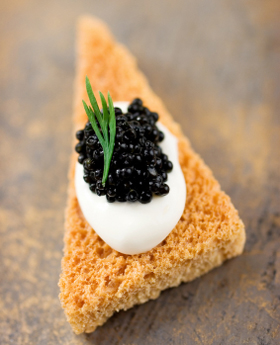
|
American Sturgeon Caviar:
The Wild Hackleback
American sturgeon, also called hackleback or shovelnose sturgeon (Scaphirhynchus platorynchus), roams wild in the Mississippi and Missouri Rivers and their tributaries; it is wild caught in Tennessee and Illinois. The glistening black eggs are small and firm. They may be the smallest size, but they have the strongest flavor—classic sturgeon, bold and forward. They’re not fishy or salty, just good.
American sturgeon caviar, once fished to the brink of extinction, is now caught sustainably in the rivers of
the central United States. Photo by Kelly Cline | IST.
|
German Osetra Caviar:
True Farmed Osetra
Cultured indoors in Germany, this is currently the only aquacultured caviar from the true osetra sturgeon, Acipenser gueldenstaedtii. It is farmed indoors, a sustainable alternative to wild Caspian osetra. The osetra is native to Germany’s major rivers as well as to the Caspian Sea and other river systems: Sturgeons were a banquet fish for German royalty throughout the Middle Ages. The careful production process creates a clean, crisp caviar with large, well-defined eggs; in bright light, you can see emerald highlights in the bead. This caviar has a light, nutty flavor with a slightly acidic finish. The eggs have a gentle pop. We liked it, but the true excitement was about to present itself.
|
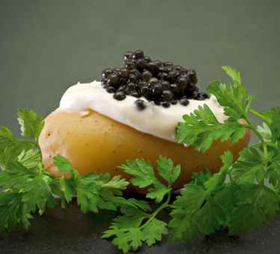
We honor the Middle Age banquet tradition with one of our favorite indulgences, the caviar baked potato. |
CAVIAR FAQs
THE MOST FREQUENTLY-ASKED QUESTIONS ABOUT CAVIAR |
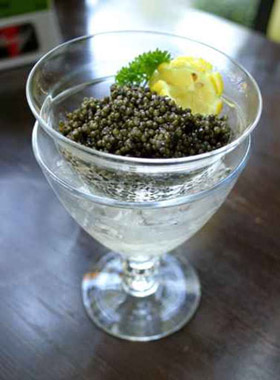
Baerii is the Siberian sturgeon, farmed in a river delta in Uruguay. |
Uruguayan Baerii Caviar:
Closest To Osetra Flavor
The Uruguayan baerii (pronounced BAY-air-ee) caviar was a revelation, the small, gleaming black eggs yielding an intense, meaty flavor. While we liked all that preceded it, this was the one to beat (and it was subsequently beaten by the even-better Transmontanus Rex, the second revelation). Baerii (Acipenser baerii baerii, the Siberian sturgeon) is probably the closest caviar to wild Caspian osetra (Acipenser gueldenstaedtii) in terms of taste. In fact, the Siberian sturgeon is a member of the osetra family, Acipenser osetra. The bead size is slightly smaller than osetra or the white sturgeon (Acipenser transmontanus), but this is a superb caviar—with bonus points because it’s sustainably cultured.
Baerii was crafted by Russian scientists in Uruguay's Rio Negro. The Rio Negro delta provides an abundance of wild plankton on which these sturgeon feed. The abundance of wild shrimp in their diet produces a rounded, complex taste—nutty, like wild Caspian osetra, with a sweeter flavor plus a firm texture. The color of the bead ranges from black with gold highlights to crimson, depending on the seasonal diet.
|
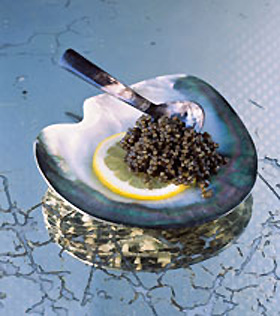
After tasting Transmontanus Rex, we were ready to work for free on the farm, in exchange for meals of caviar.
|
Transmontanus Rex Caviar:
The King Of Sustainable Caviar
This is as close to a great beluga experience as it gets these days, for most of us. And that’s fine—everyone should let those endangered, giant Huso huso attempt to reproduce themselves and not vanish from this earth. This, the most classic-looking Caspian-tasting of the caviars, with large, pearly brown-gray eggs, looked wonderful and delivered on the palate. Our friends who have consumed Caspian caviar for most of their lives would not guess that this was sustainably cultured.
Transmontanus Rex, whose name in Latin means “king of the white sturgeon,” is a variety of the white sturgeon, Acipenser transmontanus (“sturgeon beyond the mountains”). This monster, also known as the California white sturgeon and by a variety of other names, lives along the Pacific coast of North America, from the Aleutian Islands of Alaska to Central California, as well as in Western river systems like the Columbia and its tributary, the Snake River (which run through Wyoming and Idaho). There, they can grow up to 2,000 pounds for their 1,500 mile spawning run. The largest freshwater fish in North America is known, affectionately, as T-Rex.
|
And T-Rex is the largest sturgeon after the beluga. Not surprisingly, the caviar is similar in size. The flavor 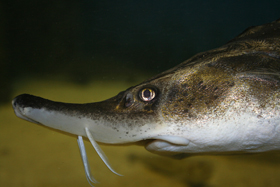 is crisp, thanks to the volcanic springs in Magic Valley, Idaho, where these fish are farmed. Spring water from an underground lake flows through the system; natural live plankton supplement the culture diet. It produces roe that can be from deep black to earthy brown to translucent blue/gray, depending on the season and the diet. The sturgeon feed on shrimp, mollusks and river plants. The caviar is dense with a strong pop and complex flavors, ranging from nutty to buttery. We enjoyed every bite of this tasting, but when we got to Transmontanus Rex, we said eureka!—as Aristotle may well have, assuming he’d been given a good portion of what was trumpeted in at those banquets. By the way, the “white” in the name of the sturgeon stems from the color of the meat, not from the external color of the fish, which is grey. Photo of sturgeon by © Coldfusion | Dreamstime. is crisp, thanks to the volcanic springs in Magic Valley, Idaho, where these fish are farmed. Spring water from an underground lake flows through the system; natural live plankton supplement the culture diet. It produces roe that can be from deep black to earthy brown to translucent blue/gray, depending on the season and the diet. The sturgeon feed on shrimp, mollusks and river plants. The caviar is dense with a strong pop and complex flavors, ranging from nutty to buttery. We enjoyed every bite of this tasting, but when we got to Transmontanus Rex, we said eureka!—as Aristotle may well have, assuming he’d been given a good portion of what was trumpeted in at those banquets. By the way, the “white” in the name of the sturgeon stems from the color of the meat, not from the external color of the fish, which is grey. Photo of sturgeon by © Coldfusion | Dreamstime.
Caviar Club & Hosted Tastings
Improve your culinary life: Have caviar more often. The Little Pearl makes it easy.
Caviar Club
One of the best ways to appreciate these fine caviars is to join the The Little Pearl’s Caviar Club. Several types of caviar rotate monthly, arriving with the appropriate blini, crème fraîche and a small mother of pearl spoon. There are two ounces of most caviars, one ounce of the costlier ones. Currently, Club members receive:
- Rainbow trout caviar with lemon dill blini
- Hackleback American sturgeon caviar with Swedish pancakes
- Alaskan keta salmon caviar with honey buckwheat blini
- White sturgeon caviar with European artisan blini
- Spoonbill paddlefish caviar with Russian blini
- Uruguayan baerii caviar with a specially paired blini
This is one club almost anyone can afford, and no one should fail to join.
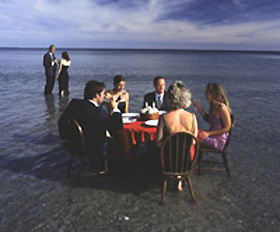 Hosted Tastings Hosted Tastings
Like to entertain? How about a caviar tasting for ten, hosted by an expert? For prices ranging from $1,200 and up, plus travel expenses, you can have these wonderful caviars and the answers to every question you’ve ever had. If you’re in Boston, tastings can be had for as little as $300; $500 for elsewhere in New England.
The Little Pearl will even send out the invitations for you. Can we add our name to the list?
Serving Suggestions
Frankly, we enjoy great caviar by itself. Anything else—blini, crème fraîche, potato slices, smoked salmon—just gets in the way of the magnificent, subtle flavors you have just spent a lot of money to experience.
We enjoyed each of The Little Pearl’s caviars off a spoon, savoring each pearl. Traditionally, mother of pearl or horn spoons are used (or gold, if you’re in that league), since other metals, even silver, can impart a metallic taste. We’ve even eaten caviar at home with a plastic spoon—yes, ordinary plastic—because we wanted to enjoy larger scoops than the little mother of pearl and horn spoons we had would provide. While we admit to having used the white ones we got free with take-out food, we’ve also bought elegant black plastic ones for guest occasions when we’ve been blessed with a gift kilo (it has happened twice in our life) and invited friends to dig in.
If you do receive a huge amount of caviar as a gift—or if you get caviar that is salty or otherwise not to your great pleasure, and you want ways to use it beyond serving it by itself, here are some suggestions): |
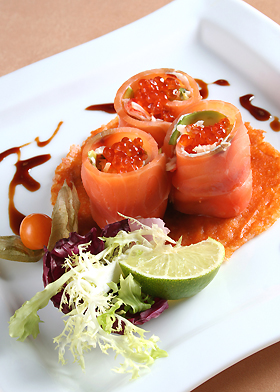
Salmon caviar rolled in smoked salmon.
Photo © Lepas | Dreamstime.
|
Breakfast
- Garnish poached, scrambled or hard-boiled eggs.
- Serve it on English muffins with crème fraîche—royalty’s version of bagels and lox.
First Course/Hors D’Oeuvre
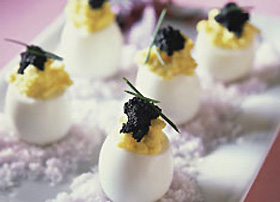 Garnish smoked salmon, tuna tartare, raw oysters or scallops. Garnish smoked salmon, tuna tartare, raw oysters or scallops. - Make the best deviled eggs ever (be sure to use top-quality mayonnaise from a specialty food store, or make your own). Here’s a recipe for deviled eggs with crabmeat and caviar. You also can hard boil eggs and dab caviar on top, remove the yolks and fill the whites with caviar.
- Serve with blini and crème fraîche (red caviar) or on boiled potato slices (black caviar) or on a potato pancake (red or black—one of our favorite treats—we also add a slice of smoked salmon).
- Fold or roll in crêpes (works best with salmon caviar) with a dab of crème fraîche.
Main Course
- Garnish fish and seafood (we love caviar on lightly-cooked scallops), or add a few beads to sauces after they have been plated.
- Tuck it into a baked potato, with crème fraîche (one of our favorite indulgences).
Cheese Course
- Garnish slices of Brie, Camembert or elegant sheep’s milk cheese (The Little Pearl likes Old Chatham’s) with paddlefish caviar.
See more serving suggestions in our favorite caviar recipes and red caviar recipes.
Life’s too short not to enjoy fine caviar. Before the holiday season gets too rushed, relax with a glass of Champagne and a caviar sampler. Or two.
—Karen Hochman
FORWARD THIS NIBBLE to anyone who likes caviar or needs to send luxurious gifts.
THE LITTLE PEARL
Sustainable Black And Red Caviars
- Per-Ounce Prices
$12.00 to $70.00
- Gift Baskets
$26.00 to $150
And Higher
Depending On
Accoutrements
- Caviar Club
$65.00/Month
Purchase online* at TheLittlePearl.com
Prices and product availability are verified at publication but are subject to change. Shipping is additional. THE NIBBLE does not sell products; these items are offered by a third party and we have no relationship with them. This link to purchase is provided as a reader convenience.
|
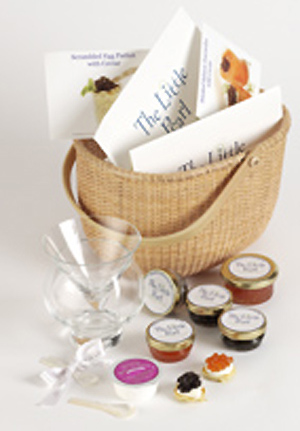
One of a variety of gift baskets. |
Read more about our favorite
caviar and seafood products:
|
Check Out These Other “Top Pick Of The Week” Seafoods:
|
FOR ADDITIONAL INFORMATION, special offers,
contests, opinion surveys, THE NIBBLE
back issues archive, product gift-finder, links to our favorite
food websites, and the ability to nominate your favorite nibbles,
visit the home page of TheNibble.com.
Do you have friends who would enjoy THE NIBBLE?
Click here to send them an invitation to sign up for their own copy. |
© Copyright 2004-2026 Lifestyle Direct, Inc. All rights
reserved. All information contained herein is subject to change at any time
without notice. All details must be directly confirmed with manufacturers, service
establishments and other third parties. The material in this e-zine may not
be reproduced, distributed, transmitted, cached, or otherwise used, except with
the prior written permission of Lifestyle Direct, Inc.
|
 |
|
 |









 northeast, Azerbaijan on the southern part of the western shore, Turkmenistan on the southern half of the eastern shore and Iran on the southern shore. The Caspian is home to seven different sturgeon species. The major caviar species fished for caviar, the enormous beluga (up to 30 feet long and 3,300 pounds), the osetra (up to 10 feet and 500 pounds) and the sevruga (6.5 feet and 175 pounds), are all on the Endangered Species List. Last year, the Convention on International Trade in Endangered Species of Wild Fauna and Flora (CITES) developed a list of conservation measures that included the restriction of Caspian caviar sales to those nations that bordered the Caspian. This measure was meant to curtail the illegal poaching that is partially responsible for the decline of the sturgeon (pollution and damming of rivers, which are the sturgeons’ spawning grounds, the killing of the sturgeon to take their eggs, and extensive illegal poaching are the others). Over the past 10 years, other countries have begun caviar farming, for both preservation and to meet consumer demand. The beluga is too large to be farmed, but the osetra has found success, as you’ll see in the tasting notes below.
northeast, Azerbaijan on the southern part of the western shore, Turkmenistan on the southern half of the eastern shore and Iran on the southern shore. The Caspian is home to seven different sturgeon species. The major caviar species fished for caviar, the enormous beluga (up to 30 feet long and 3,300 pounds), the osetra (up to 10 feet and 500 pounds) and the sevruga (6.5 feet and 175 pounds), are all on the Endangered Species List. Last year, the Convention on International Trade in Endangered Species of Wild Fauna and Flora (CITES) developed a list of conservation measures that included the restriction of Caspian caviar sales to those nations that bordered the Caspian. This measure was meant to curtail the illegal poaching that is partially responsible for the decline of the sturgeon (pollution and damming of rivers, which are the sturgeons’ spawning grounds, the killing of the sturgeon to take their eggs, and extensive illegal poaching are the others). Over the past 10 years, other countries have begun caviar farming, for both preservation and to meet consumer demand. The beluga is too large to be farmed, but the osetra has found success, as you’ll see in the tasting notes below. 

 manner that does not deplete the resource. No sturgeon are killed, as with traditional caviar harvesting. The company is a member of Seafood Choices Alliance, Slow Food and the Edible Communities.
manner that does not deplete the resource. No sturgeon are killed, as with traditional caviar harvesting. The company is a member of Seafood Choices Alliance, Slow Food and the Edible Communities.







 is crisp, thanks to the volcanic springs in Magic Valley, Idaho, where these fish are farmed. Spring water from an underground lake flows through the system; natural live plankton supplement the culture diet. It produces roe that can be from deep black to earthy brown to translucent blue/gray, depending on the season and the diet. The sturgeon feed on shrimp, mollusks and river plants. The caviar is dense with a strong pop and complex flavors, ranging from nutty to buttery. We enjoyed every bite of this tasting, but when we got to Transmontanus Rex, we said eureka!—as Aristotle may well have, assuming he’d been given a good portion of what was trumpeted in at those banquets. By the way, the “white” in the name of the sturgeon stems from the color of the meat, not from the external color of the fish, which is grey.
is crisp, thanks to the volcanic springs in Magic Valley, Idaho, where these fish are farmed. Spring water from an underground lake flows through the system; natural live plankton supplement the culture diet. It produces roe that can be from deep black to earthy brown to translucent blue/gray, depending on the season and the diet. The sturgeon feed on shrimp, mollusks and river plants. The caviar is dense with a strong pop and complex flavors, ranging from nutty to buttery. We enjoyed every bite of this tasting, but when we got to Transmontanus Rex, we said eureka!—as Aristotle may well have, assuming he’d been given a good portion of what was trumpeted in at those banquets. By the way, the “white” in the name of the sturgeon stems from the color of the meat, not from the external color of the fish, which is grey.  Hosted Tastings
Hosted Tastings

